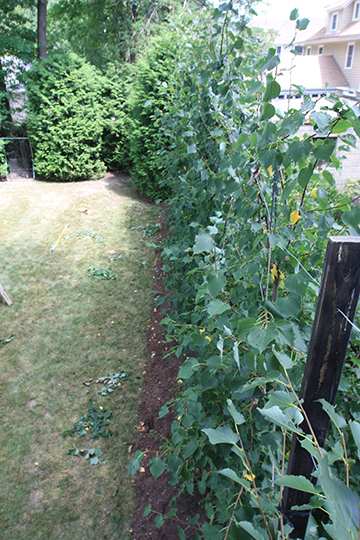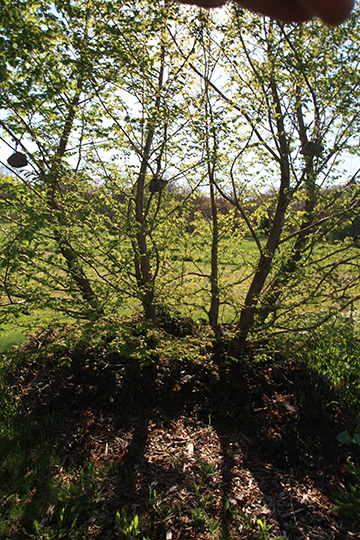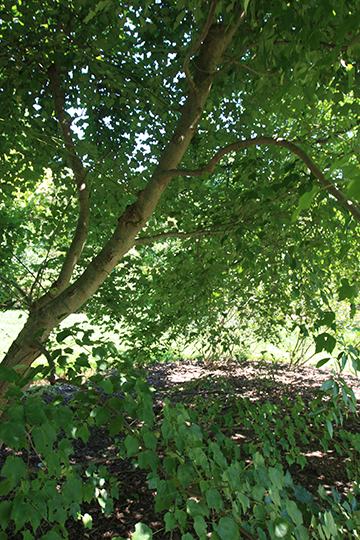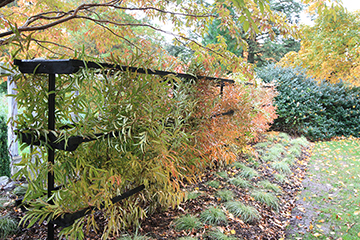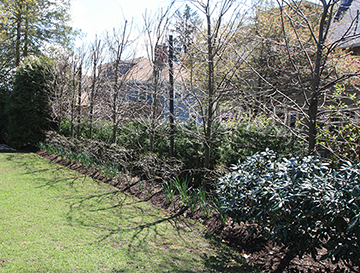Spring 2023 Newsletter
| Pruning, Pleaching, Planting Tunnels and Cloistered Bowers |
| Some of Warren's Favorite Drought Tolerant Plants |
Pruning, Pleaching, Planting Tunnels and Cloistered Bowers
The signature silhouette of a tree’s natural form may easily reveal its identity, even from a distance. The iconic vase-shaped canopy of the American elm, the stiffly ascendant branches of columnar oak, and the pendulous cascade of weeping willow foliage are examples unique to these individual tree varieties. The configuration of their branches shows off shapes that structurally embellish the designed landscape and garden.
Creative pruning can transform the raw form of a tree into a novel, ornamental sculptural composition. Pleaching (or plashing) is an ancient utilitarian method of training trees. Pliable branches are bent down and interwoven to form dense hedges. English farmers, in the early eighteenth century, utilized pleaching hedgerows to form barriers to contain livestock.
Pleaching can transform a row of trees or shrubs into a narrow, rectilinear panel of hedges or enclosing bowers.
Pleaching methods are generally applied to deciduous trees. Landscape designers and horticulturists capitalized on this technique and adapted it to design and make ornamental garden structures. The zenith of pleaching is perhaps the Belgian fence. It is often composed of apple trees trained in a diamond lattice pattern. The diagonally crossing branches fuse together, and the top consists of woven branches. A fine example of this sculptural art is at Bedrock Gardens in New Hampshire, planted and sculpted by Bob Munger and Jill Nooney.
At Tranquil Lake Nursery, I planted a much simpler composition of pleached dwarf crab apples. I trained a pleached hedge of ‘Cinderella’ (See photo below) into a double row of horizontal cordons. Malus ‘Cinderella’ is top-grafted on top of standard trunks. Four trees form this horizontal aerial hedge that outlines a circular gravel garden. White springtime flowers are followed by colorful yellow fruits that persist into the winter season. Flowering crabapples (Malus) are malleable to many pruning techniques, from being pleached to espaliered.
Pleached bowers provide a rare bit of garden enchantment. I planted a circular bower of crabapples to form a focal point threshold, leading into a mixed herbaceous garden. When in bloom, the bower is a fragrant white cloud that casts a pattern of cool shade that contrasts with adjacent sunny borders. The garden in North Grafton, MA, was planted in August of 1998. Six Malus x ‘Sugar Tyme’ form the bower. They were planted around the circumference of an eighteen-foot diameter circle. After several years of development, training wires were strung across the circular bower to make a frame to tie down and bend the longest growth of branches and establish a closed canopy. After several more years of pruning and training, the bower was structurally complete. It is now pruned once a year, in late August or early September.
Lindens (Tilia cordata), with their pyramidal shape and slow growth, are good specimens for pleaching. Several years ago, we were engaged to pleach a row of little leaf linden trees that had been planted in Waban, MA. We installed a framework of horizontal wires to facilitate the pleached transformation and training, tying and weaving the branches into a flat panel. Their winter aspect is much more complex than a simple flat veneer of green foliage. (See photo below) This multitude of exposed branches magnifies the pleached hedge’s dimensional presence in the winter garden. It is a wiry filigree of intertwined twigs that shows off its full anatomical structure.
Asian spicebush (Lindera angustifolia) is one of my favorite shrubs. Its beautiful foliage makes it a prime candidate to pleach into a beautiful horizontal panel. Its linear green leaves turn pumpkin orange in the fall. Wintertime marcescent foliage turns coppery tan and is held onto the branches all winter. We constructed a simple, double-sided wooden frame made of three horizontal wooden slats, to which we tied the supple Lindera branches.
Trees with pendulous weeping branches appear to submit to the forces of gravity in opposition to phototropism and the strong influence of the sun in the direction of stem growth. An unusual and rare form of red maple is the cultivar ‘Weepy’ (Acer rubrum ‘Weepy’). It grows into a mounded form of arching and weeping branches. At the nursery, we planted a double row of this weeping red maple to form a shady arched tunnel on the edge of a meadow of little blue stem grasses and wildflowers. Its red fall foliage color and gray winter stems add year-round beauty to its ornamental arching form.
Add a sculptural pleached panel or arch to accent your garden.
by Warren Leach
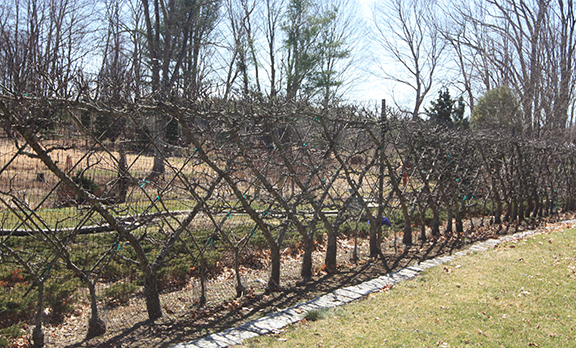 |
|
Belgian Fence |
Linden Fence |
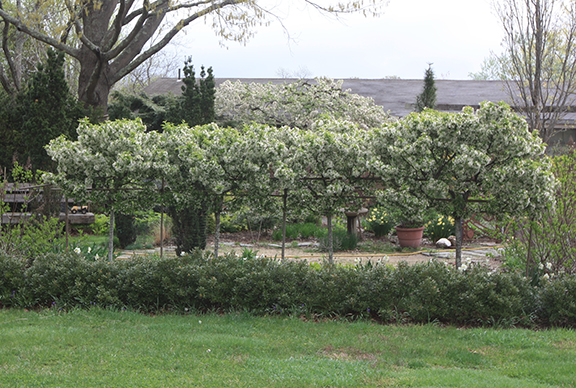 |
|
Malus 'Cinderella' at Tranquil Lake Nursery |
Training branches using weights at the nursery |
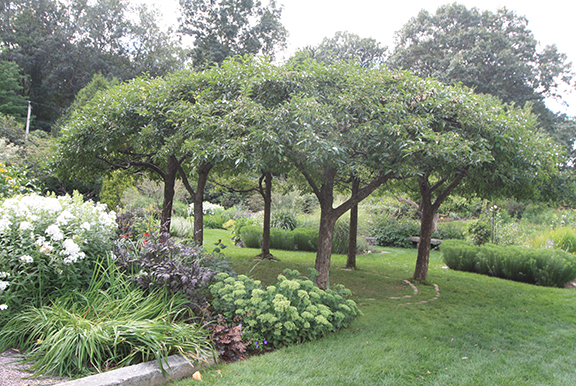 |
|
Malus x 'Sugar Tyme' Bosque in North Grafton |
Acer rubrum 'Weepy' |
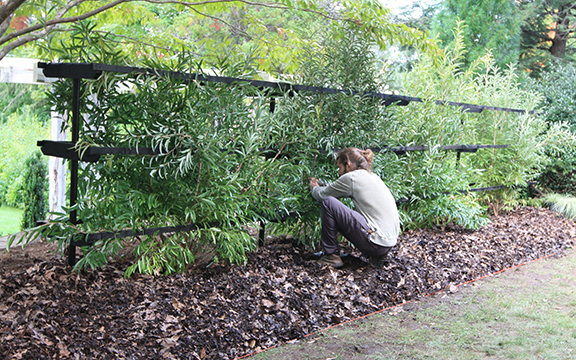 |
|
Training a Lindera Fence |
Lindera Fence in Fall |
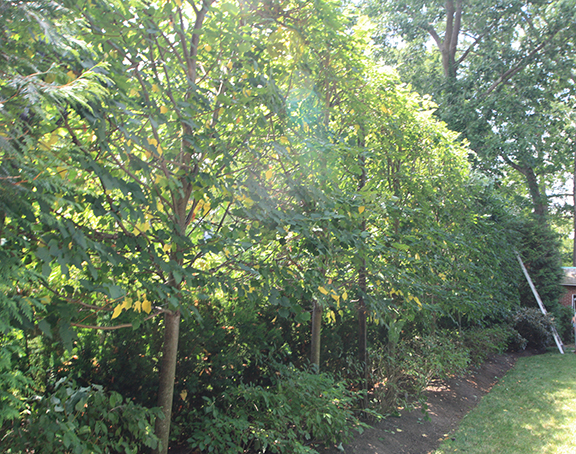 |
|
Pruning a Linden Fence |
Linden Fence in Winter |
Some of Warren's Favorite Drought Tolerant Plants
Anyone who has met Warren Leach and talked with him about the garden at Tranquil Lake Nursery knows that plants are his passion. He has spent 38 creating the gardens at the nursery, where many of his favorite plants have found a home. The nursery has sandy loam soil, so he especially experiments with drought-tolerant plants in the gardens. It is hard to select a list of Warren's most favorite plants. Going through the nursery today, here are just some of the plants for which he has been singing the praises. Most are drought tolerant and will do well in the hot dry summers that have become the norm here in Southern New England.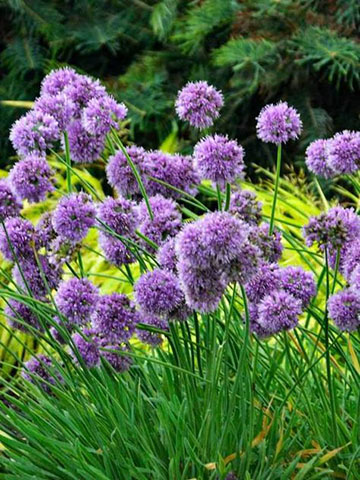 |
Allium ‘Medusa’ is an Ornamental Onion with green strap-like leaves that curl and twist on the ends - just like Medusa’s hair. The light purple drumstick flowers to 2" wide emerge above the foliage in late summer and early fall on long, sturdy stems. When the bloom is finished, you can still enjoy the dried seed-heads. Similar in flower color to ‘Blue Eddy’, but in a much larger form. 24 inches tall and wide. Plant in full sun in well-drained soil. Drought tolerant. Rich in nectar, the butterflies and other pollinators love it. Deer and rabbit resistant.
The gardens at the nursery showcase a number of Alliums that provide food for insect pollinators throughout the summer. We also have Allium senescens 'Blue Eddy', Allium x Millennium, Allium x 'Pink Planet' and Allium x 'Windy City' in containers. |
Allium ' Medusa' |
|
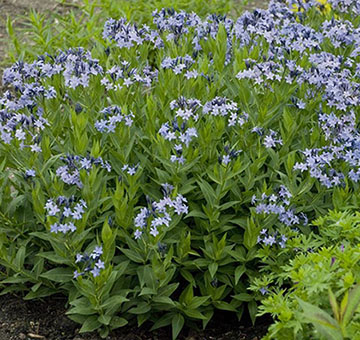 |
Amsonia x ‘Blue Ice’ is a more compact form of blue star, reaching just 15 to 18 inches tall. The flowers are also a darker blue that Amsonia tabernaemontana. An erect, clump forming perennial that features terminal, star-like, dark lavender blue flowers in late spring. Leaves are narrow and willow shaped, dark green turning yellow in fall. Requires no staking or support. Plant in full sun in well drained soil. Deer tolerant. Attractive to pollinators, including the hummingbird clearwing moth. Zone 4 to 9,
There are quite a few cultivars of this native plant in the gardens at Tranquil Lake Nursery. All thrive without any additional water. We also have Amsonia hubrichtii, Amsonia tabernaemontana 'Salicifolia' and Amsonia tabernaemontana 'Storm Cloud' in containers. |
Amsonia x 'Blue Ice' |
|
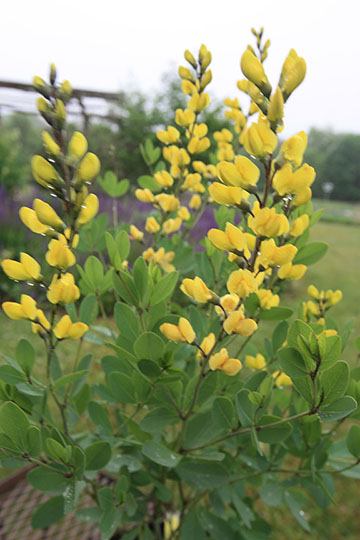 |
Baptisia x 'American Goldfinch' is a large floriferous False Indigo that produces bright yellow spikes of pea-shaped flowers for a prolonged period in spring and early summer. The flower spikes are followed by large round seed pods held above the neat green foliage throughout the summer. 40 inches tall and 60 inches wide. Plant in full sun in average well drained garden soil. Deer and drought resistant. Hardy from Zone 4 - 8.
Baptisia can't be beat as a drought tolerant garden plant with phenomenal structure in the garden. We also have Baptisia australis, Baptisia x 'Decadence Lemon Meringue', Baptisia x 'Decadence Vanilla Cream', Baptisia x 'Lemon Meringue and Baptisia x 'Purple Smoke' in containers. |
Baptisia australis 'American Goldfinch' |
|
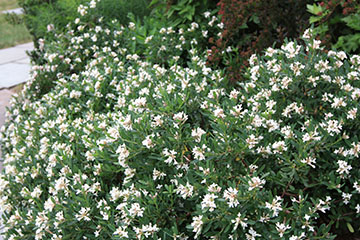 |
Daphne x transatlantica ‘Eternal Fragrance’ features intensely fragrant white flowers, with an orange-yellow eye and orange anthers, in spring with irregular sporadic continued bloom on new growth from summer into fall. Branches are clad with semi-glossy, narrow, elliptical, dark green leaves (2" long). Typically grows in a mound to 2-3' tall and wide. Flowers turn pink-purple when night temperatures are cool. Plant in shade in moist, humusy, well-drained soil. Mulch in winter.
This may not be the most popular Daphne at the nursery, but it runs a close second to our gregarious poodle. We have 'Eternal Fragrance' in containers and also field dug b and b. |
Daphne x transatlantica 'Eternal Fragrance' |
|
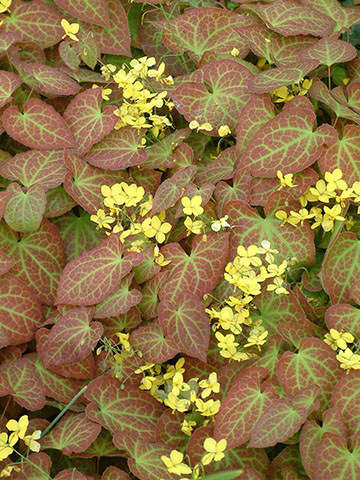 |
Epimedium x perralchicum ‘Frohnleiten’ This Barrenwort or Bishop hat is a compact, 4-6" tall cultivar distinguished by its brighter yellow flower color and bloom which rises in airy clusters above the semi-evergreen foliage. Spiny green leaves are bronze marbled in spring and fall. Clump forming ground cover for shady area, that will spread by rhizomes. Plant in part to full shade in average, well drained soil. Prefers evenly moist loamy soil. Deer tolerant. And rabbit resistant.
Epimedium is well known for its drought tolerance, even under those troublesome Maple trees. We also have Epimedium Spp. nova 'Spine Tingler', Epimedium x rubrum, and Epimedium x warleyense 'Orange Queen' in containers. |
Epimedium x perralchium 'Fronleiten' |
|
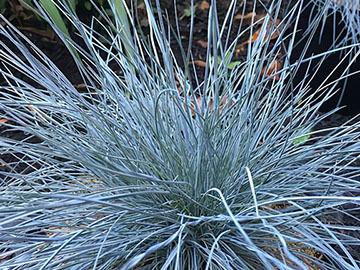 |
Festuca glauca ‘Beyond Blue’ is valued for its clumping habit, and display of colorful, grassy foliage. This selection forms a dense tuft of slender cascading foliage that is intensely silver-blue all season. 9 to 12 inches tall and 16-18 inches wide. Light green flowers with a purple tinge appear in terminal panicles atop stems that rise above the foliage in late spring to early summer. Flowers give way to buff-colored seed heads. Impressively tolerant to cold, heat, humidity, low water, deer and poor soil conditions. Excellent for mass planting, edging or in the rock garden. Plant in full sun in well drained soil. Zone 4 to 9. |
Festuca glauca 'Beyond Blue' |
|
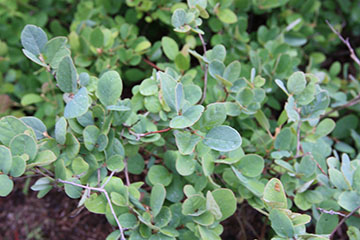 |
Fothergilla gardenii ‘Blue Elf’, the Blue Elf Dwarf Witch Elder, is a hybrid between Fothergilla gardenii 'Blue Mist' & Fothergilla gardenii 'Harold Epstein'. The former is a compact, blue foliaged form introduced by the Morris Arboretum in Philadelphia. 'Harold Epstein' is a very dwarf gem from Harold's Larchmont garden in New York. 'Blue Elf ' features the blue foliage of 'Blue Mist', with an intermediate size between the two parents. Fragrant, white, bottle-brush-like flowers in early spring and orange fall foliage color. Plant in full sun to part shade in moist, organically rich, well-drained soil. Native to southeastern US. Zone 5 to 8.
Selected and named by Warren Leach for Tranquil Lake Nursery. |
Fothergilla 'Blue Elf' |
|
Hippophae rhamnoides ‘Sprite’ is a male selection of Seabuckthorn boasting ample, willow-like, silvery foliage held on a compact framework. Perfect as a low maintenance filler plant or for informal hedging. As a male selection, it is unable to produce seed and become a pest. Naturalizes by root suckers. Plant in full sun, in average, well drained soil. Excellent in challenging sites where low fertility, drought and extremes in temperature plant growth. Wind tolerant. Zone 4 to 8.
This is one of Warren's favorite plants for the really tough dry conditions such as banks and side walk hell strips. No longer available in nurseries, Warren has this propagated every year just for use bu Tranquil Lake Nursery. |
|
Hippophae rhamnoides 'Sprite' |
|
 |
Indigofera gerardiana (Also known as Indigofera heterantha) is known as Himalayan Indigo. This lovely and unusual shrub, native to dry and sunny slopes in the Himalayas from Afghanistan to China. Clusters of deep, purple-rose colored, pea like flowers from June to fall. They stand out against the delicate grayish green to gray silver colored foliage. Drought tolerant, and will tolerate full sun to part sun. It is a spreading deciduous shrub that reaches a height of 8 feet and a width of 8 feet. Likes a hard pruning. Zone 5. Has received the Royal Horticultural Society’s Award of Garden Merit. Zone 5 to 8 |
Indigofera gerardii |
|
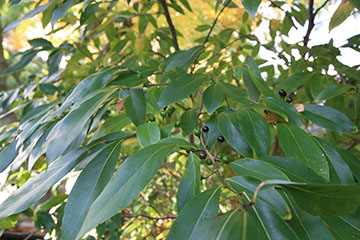 |
Lindera angustifolia, the Willowleaf Spicebush features narrow, leathery green leaves that turn the most spectacular combination of orange, red and purple in fall. Leaves are held throughout the winter, turning a very attractive tan. Leaves drop in early spring. Since it holds its leaves it offers a screening alternative to evergreens. Tiny yellow flowers on bare stems in early spring, followed by small shiny black fruit in fall. Teaches 10 feet tall and 6 feet wide. Plant in full sun to part shade in average to dry soil. Deer resistant. A shrub for all seasons. Zone 5 to 9.
This is one of Warren's favorite plants for screening air conditioners and unsightly neighbors yards, due to its 4 season leaf habit. |
Lindera angustifolia |
|
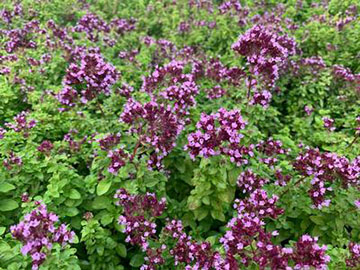 |
Origanum x ‘Drops of Jupiter’ is a golden-leaved oregano that is a hybrid, ornamental oregano selection that features fragrant, chartreuse-yellow foliage and dense, terminal clusters of fragrant pink flowers surrounded by persistent, dark purple sepals from mid-summer to early fall. Although the leaves are edible, they are not as intensely flavored as culinary oregano. To 2 feet tall and 3 feet wide. Plant in full sun in well-drained soil. Does very well in gritty sandy soil. Deer tolerant. Zone 4 to 9. |
Origanum x 'Drops of Juniper' |
|
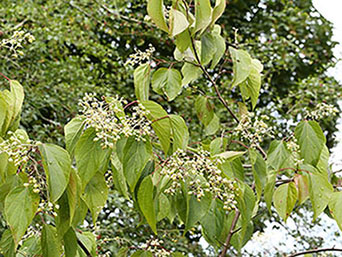 |
Poliothyrsis sinensis, known as the Chinese Pearlbloom produces large, ovate leaves that emerge in spring flushed with iridescent burgundy overtones, then age to rich, glossy green by early summer, then turn yellow in fall. By August, plants are cloaked with a wonderful display of finely textured, creamy-white, terminal flower panicles on red stems, that look like pearly buds and are fragrant. A rarely seen small tree to 20-40 feet in height. Collected in China by E.H. Wilson in 1908. Plant in full sun to partial shade in well-drained soil. Zone 6 to 9. |
Poliothrysis sinensis |
|
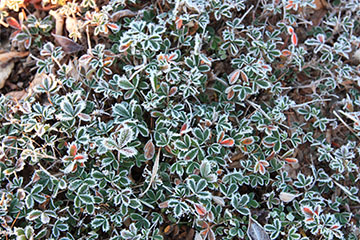 |
Potentilla (Sibbaldiopsis) tridentata or Wine-leaf Cinquefoil is a short evergreen perennial plant growing up to 10 inches tall. Compound, trifoliate leaves grow up to 1 ½” in length and are arranged in an alternate pattern. Leaves are glossy green and evergreen, turning deep red in fall. Flowers are small and white and bloom from June to August. Plant in full sun in well-drained soil. Spreads by underground roots. Drought tolerant. Native to Eastern North America where it grows in rocky and gravelly soil. Zone 5 to 8.
Warren uses Wine-leaf Cinquefoil to replace lawns and also as an understory plant in the garden troughs. It takes some foot traffic and is very drought tolerant, growing on the rocky soil at the top of Cadillac Mountain in Maine. |
Potentilla tridentata |
|
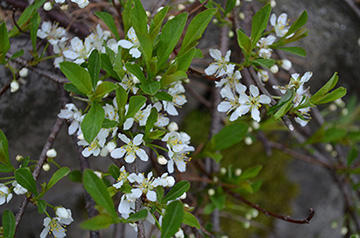 |
Prunus pumila var depressa 'Gus Mehlquist' is an extremely low-growing sprawling sand cherry found along the bank of the Connecticut River in Cheshire County, New Hampshire. Collected and propagated by the Arnold Arboretum, it stands only 6-12 inches above the ground, compared to the 9-foot-tall height that a sand cherry shrub can attain. Flowers are dainty with five white petals, followed by blue-black fruits in September. It has elliptic dark green foliage through the growing season, with fall colors displaying brilliant crimson and maroon hues. Performs well in normal garden conditions and displays bolder fall foliage when planted in full sun. It is extremely adaptable to both dry and wet sites. |
Prunus pumila var. depressa 'Gus Mehlquist' |

